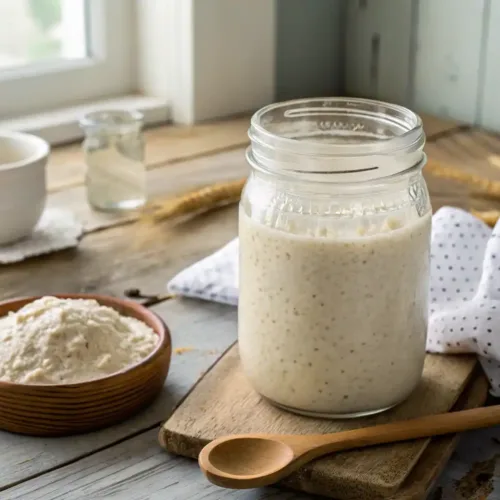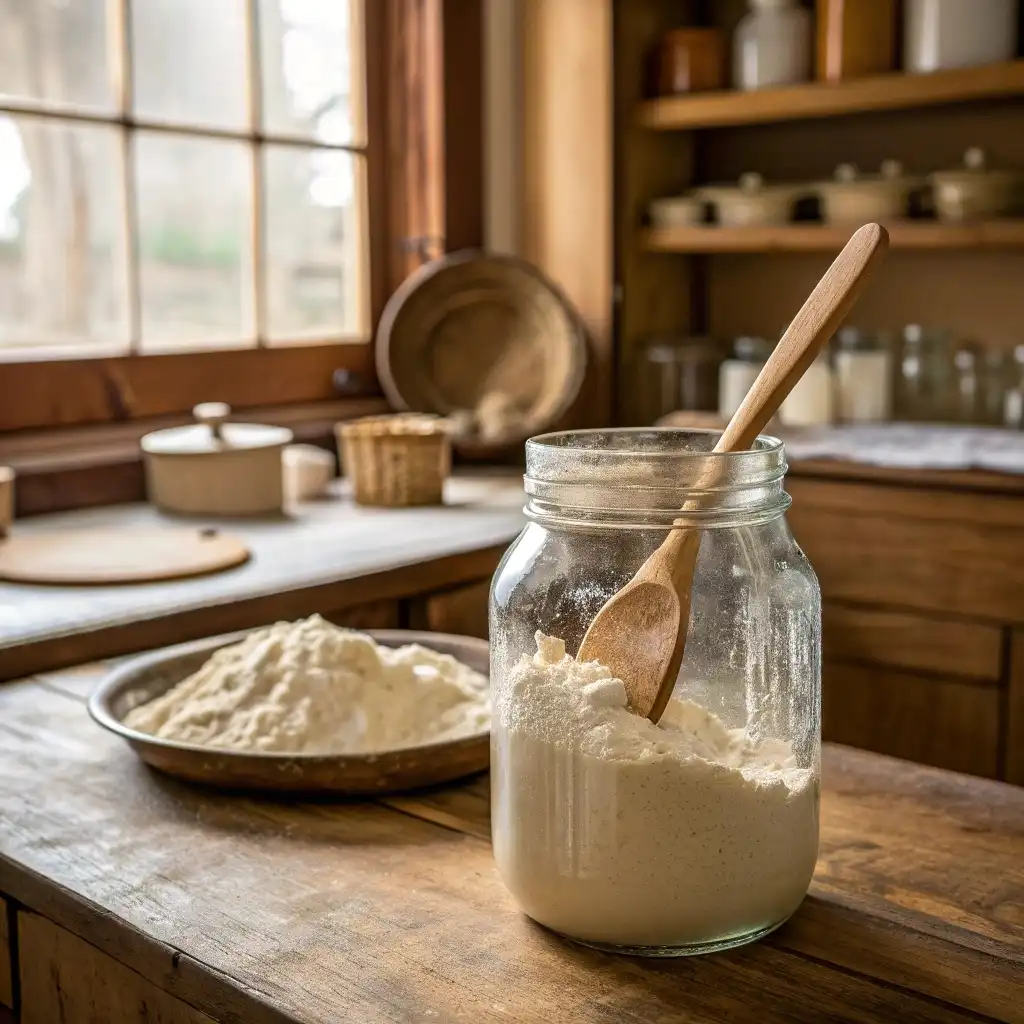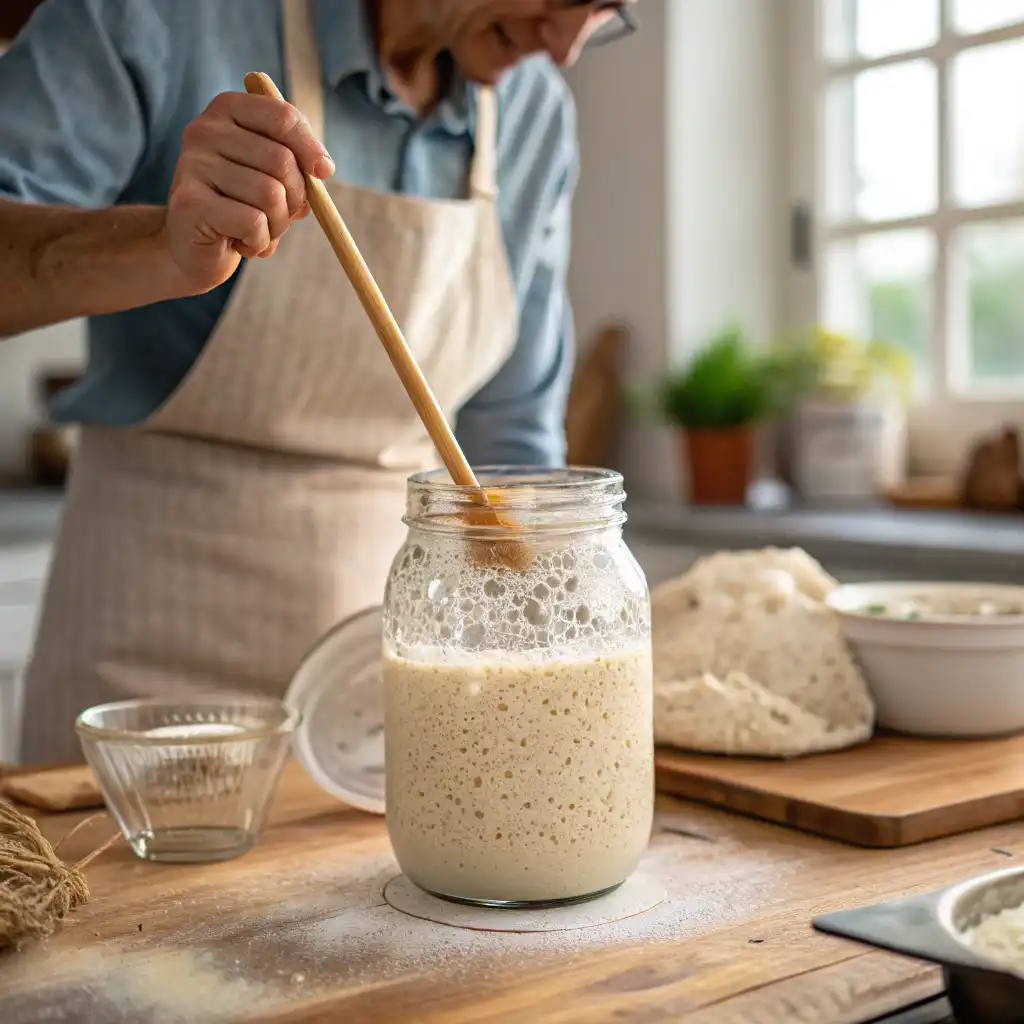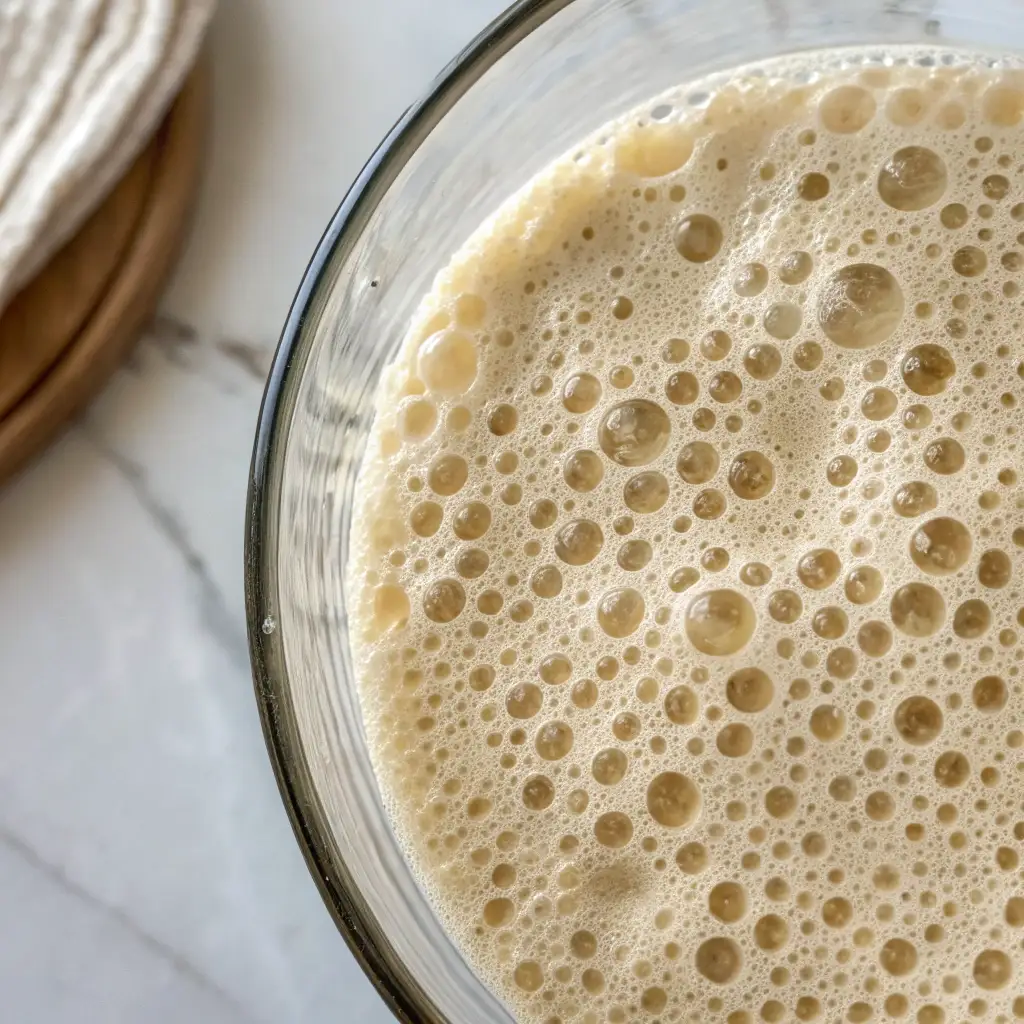Feeding your sourdough starter is one of the most important things you can do to keep your culture healthy and alive. Feeding means adding fresh flour and water to your starter so the natural yeast and bacteria can keep growing and staying strong. If you forget to feed your starter or don’t do it at the right time, it might get weak and have trouble helping your dough rise. In this article, we’ll explain the best feeding ratios, how often to feed your starter, and some easy tips to help if things go wrong.
👉 If you’re new to sourdough, you might also want to check out our full guide: Sourdough Starter: The Complete Guide to Making, Feeding, and Fixing It.
TABLE OF CONTENTS
Table of Contents
What Does Feeding a Sourdough Starter Mean?
Feeding your starter means putting in some fresh flour and water to help the wild yeast and bacteria stay alive and active. Over time, the mixture consumes the available nutrients, so refreshing your sourdough culture is necessary to restore its strength. This routine is all about nourishing your starter so it stays active, bubbly, and full of life. With consistent attention, you’ll keep your sourdough starter healthy and ready to help your bread rise perfectly every time.
If you’re new to the process, these simple sourdough feeding instructions will help you build a healthy culture from day one.
👉 Don’t miss our step-by-step guide: How to Make a Sourdough Starter from Scratch: A No-Fail, Day-by-Day Recipe.

How to Feed a Sourdough Starter
Ingredients
- 100 g sourdough starter (from jar)
- 100 g flour (all-purpose or bread flour)
- 100 g filtered water (room temperature)
Instructions
- 1. Take your jar of sourdough starter. Discard about half of it, leaving 100 g.2. Add 100 g flour and 100 g filtered water.3. Stir until smooth, with no dry flour remaining.4. Cover loosely and leave at room temperature (21–24°C) for 4–12 hours.5. The starter is ready when it has doubled in size, looks bubbly, and smells pleasantly tangy.
Notes
Nutrition
How Often Should You Feed a Sourdough Starter?
The frequency of feeding your starter depends on how often you bake and the temperature of your kitchen. At room temperature, most bakers find that nourishing your starter once every 24 hours is enough to keep it strong and active. If you bake daily, you may need to refresh it more frequently.
When stored in the fridge, the culture slows down, so you can maintain it by refreshing your sourdough culture just once a week. No matter your schedule, consistency is key to maintaining a sourdough starter that’s always ready to use.
How to Feed a Sourdough Starter (Step-by-Step)
Good feeding habits help your sourdough culture stay healthy and strong. Here’s an easy way to feed your sourdough at home:
- Discard Remove about half of your starter. This helps keep the acidity at a good level and stops it from becoming too much.
- Add flour and water – Use the same amount (by weight) of flour and water. This ensures your culture gets the food it needs.
- Stir thoroughly until all the flour is completely mixed and there are no dry spots left. A smooth mixture helps the yeast and bacteria spread evenly.
- Wait – Leave your jar loosely covered at room temperature. Within a few hours, bubbles will appear, showing that your culture is active.
By nourishing your starter this way, you’re ensuring it stays strong and predictable, ready for baking whenever you need it.

👉 If you’re starting from scratch, check our detailed guide: How to Make a Sourdough Starter from Scratch.
Choosing Flour and Water for Feeding
When it comes to feeding your starter, the type of flour and water you use can make a big difference. Flour is the main food source, so using high-quality, unbleached flour is essential for nourishing your starter. Whole grain flours like whole wheat or rye provide extra minerals and nutrients, which help your starter stay active and bubbly.
👉 For more detailed tips on selecting the best flour, check out our full guide: Best Flour for Sourdough Starter: A Complete Beginner’s Guide.
Water is just as important. Chlorinated tap water can harm the natural microbes, so it’s best to use filtered, bottled, or dechlorinated water. Consistency is key once you choose a flour and water type, try to stick with it for stable results in maintaining a sourdough starter.
Feeding Ratios Explained (1:1:1, 1:2:2, etc.)
When refreshing your sourdough culture, bakers often follow specific ratios of starter : flour : water by weight. These ratios determine how quickly the starter will grow and how active it will be before baking.
1:1:1 ratio → Equal parts of starter, flour, and water.
Great for daily feedings at room temperature.
1:2:2 ratio → One part starter, two parts flour, and two parts water.
Best when you want to slow fermentation slightly or prepare a stronger starter for baking.
1:3:3 (or higher) → Ideal when leaving your starter for longer periods, like overnight, since more food keeps it active longer.
Here’s a quick table for clarity:
Ratio Starter (g). Flour (g) Water (g) Best Use Case
1:1:1 50 50 50 Daily feeding at room temp
1:2:2 30 60 60 Stronger starter, slower rise
1:3:3. 20 60 60 Longer rest periods, overnight
📌 Think of these ratios as your sourdough feeding instructions. Adjusting them gives you control over timing and activity levels.
Troubleshooting Feeding Issues
Even experienced bakers sometimes face challenges when feeding their sourdough starter. Here’s how to fix common problems:
Starter isn’t rising
Possible causes: Temperature too low, underfed, or weak starter.
Fix: Move to a warmer spot (70–75°F / 21–24°C) and follow consistent sourdough feeding instructions.
Unpleasant smell
Possible causes: Overfermentation or contamination.
Fix: Stir the starter, discard some, and refresh with new flour and water. If mold appears, it’s best to start over.
Too runny or thick
Possible causes: Incorrect water-to-flour ratio.
Fix: Adjust the feeding ratio according to the schedule in our previous table.
Starter separates or develops liquid layer (hooch)
Fix: Mix the liquid back in and feed right away. This is a natural sign your starter is hungry, not necessarily spoiled.
📌 For more advanced fixes and tips, refer to our pillar article: Sourdough Starter: The Complete Guide to Making, Feeding, and Fixing It.
How to Revive a Neglected Starter

Sometimes, your starter might be forgotten for a few days—or even weeks. Refreshing your sourdough culture properly can bring it back to life:
- Assess the starter Look for mold or foul odors. If it smells sour but not rotten, it’s usually safe to revive.
- Discard most of it Keep only a small portion (about 1–2 tablespoons) to prevent over-acidification.
- Feed generously Add fresh flour and water in a 1:2:2 or 1:3:3 ratio to give the microbes plenty of food.
- Repeat feedings – Feed every 12–24 hours until the starter becomes bubbly and doubles in size consistently.
- Maintain a schedule – Once revived, return to your regular sourdough feeding instructions to keep it strong.
By nourishing your starter after neglect, you can save a previously inactive culture and keep it ready for baking again.
FAQs About Feeding a Sourdough Starter
Q1: Do you need to discard every time you feed?
Not necessarily. Discarding helps control the acidity and volume, but if your starter is small, you can sometimes feed without discarding. Just make sure it doesn’t grow too large or become too acidic.
Q2: Can you use different flour for feeding?
Yes! You can switch between whole wheat, rye, or all-purpose flour. Keep in mind that whole grain flours generally produce more bubbles and faster fermentation.
Q3: What if my starter smells strange?
A tangy, sour smell is normal, but a rotten or moldy odor means it’s contaminated. Discard the starter and start fresh if mold is present.
Q4: How often should I feed a refrigerated starter?
Once a week is usually enough, but if it’s very sluggish, you can feed it twice a week to maintain strength.
Q5: Can I feed with water at different temperatures?
Room temperature water is best. Too cold slows yeast activity; too hot can kill it.
📌 These FAQs cover the most common concerns about maintaining a sourdough starter and keeping it active for baking.
Want to save some of these recipes? Visit my Pinterest or Facebook page where I have a huge collection of the best sourdough recipes and information on the web.
Conclusion + Call-to-Action
Feeding your sourdough starter is the foundation for a healthy, active, and reliable culture. By following the right sourdough feeding instructions, using quality flour and water, and keeping a consistent schedule, you ensure your starter stays bubbly and strong for every bake.
To continue your sourdough journey:
Learn how to make a starter from scratch: How to Make a Sourdough Starter from Scratch
Discover the best flour choices: Best Flour for Sourdough Starter
Dive deeper into maintenance and troubleshooting: Sourdough Starter: The Complete Guide to Making, Feeding, and Fixing It
With these resources and the tips in this guide, you’ll master the art of nourishing your starter and enjoy perfect sourdough bread every time.

